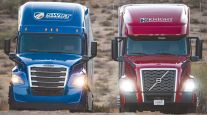Year in Review: Orders for Heavy-Duty Trucks Grew in Nine of First 10 Months of 2013
This story appears in the Dec. 23 & 30 print edition of Transport Topics.
Orders for heavy-duty North American trucks grew in nine of the first 10 months of the year, as industry watchers wondered when the mild slump in U.S. truck sales would end.
Finally, in September, sales did turn around.
August was the 12th straight month of sales declines measured year-over-year, but evidence that the drought had ended grew in October and November as sales increased for a second and then third month in a row, according to figures from WardsAuto.com.
Even after the three months of growth, though, 11-month sales lagged behind 2012’s pace by 6.5%.
New-truck production fell even further than sales as manufacturers drew down inventories to complete many deals.
Among other original equipment manufacturers, medium-duty U.S. truck sales grew in 10 of the year’s first 11 months, as volume in Classes 4-7 rose by 10.1% over the corresponding time in 2012, Ward’s said. The three major weight classes — 7, 6 and 4/5 combined — showed growth after 11 months.
U.S. sales of used Class 8 trucks also grew during the year. IHS Automotive’s Polk unit said registration data show that used-truck transactions increased by 7.6% over the first nine months relative to the pace from the year before.
However, trailer sales did fall, IHS said. Through three quarters, U.S. businesses registered 166,814 new trailers, or 1.6% fewer than during the same time in 2012.
The year was good for continuing technological change.
Navistar International Corp. substantially advanced its switch to selective catalytic reduction technology — the last OEM to adopt SCR after the 2010 regulatory change.
Two related court cases largely wrapped up the controversy that began in 2010. A federal appeals court said in October that a request by Daimler AG and Volvo Group to continue a dispute with EPA and Navistar over an interim nonconformance rule was moot. Recently, a federal appeals court tossed EPA’s rule that allowed Navistar to pay penalties to sell nonconforming engines.
Several OEMs offered trucks and engines compliant with next year’s greenhouse-gas rule for most of 2013, and the Obama administration said carbon dioxide standards might tighten again in 2019, even after they do so in 2017.
Early adoption of the 2014 standards was considered desirable because the strategy for emitting less CO2 is to burn less fuel — a goal of every truck fleet manager.
Natural-gas engines for trucks came of age this year as the Cummins Westport joint venture unveiled its ISX12 G power plant with spark ignition for either compressed or liquefied natural gas. All four major truck manufacturers are using the engine in their heavy-duty vehicles this year.
The 12G adds a larger option to the 9-liter ISL G, which has been available for years.
Westport Innovations, the Canadian half of Cummins Westport, said in the fall it would discontinue its 15-liter truck engine with high-pressure direct-injection, leaving the 12G as the main heavy-duty nat-gas engine for the present.
The Canadian company this month also unveiled Westport HDPI 2.0, for heavy-duty engines. The technology will be used next year and in 2015 as Volvo and Mack said they would team with Westport to make a 13-liter engine that will run on LNG.
IHS Automotive started tracking the sale of nat-gas truck engines this year and said that, during the first nine months of the year, 3,175 CNG engines were installed at the factory in Classes 4-8 vehicles, and 1,645 propane-powered engines were installed in Class 7s.
There also was some shifting among major OEM executives during the year.
Andreas Renschler moved to a position at Daimler AG’s Mercedes-Benz car division, and Wolfgang Bernhard succeeded Renschler as chief of Daimler’s global trucks division.
Bill Kozek left Paccar Inc. and became president of Navistar’s North American truck and parts businesses, succeeding Jack Allen, who was promoted to the company’s chief operating officer. Additionally, the company announced that Paccar President Ronald Armstrong will succeed Mark Pigott as CEO on April 27. Piggott will remain executive chairman of the OEM’s board of directors — a position he has held, along with CEO, since 1997.
Darrin Siver replaced Kozek as general manager of Peterbilt Motors Co.
Mack Trucks said that Kevin Flaherty retires as company president at the end of the year, and Stephen Roy will succeed him on New Year’s Day.




